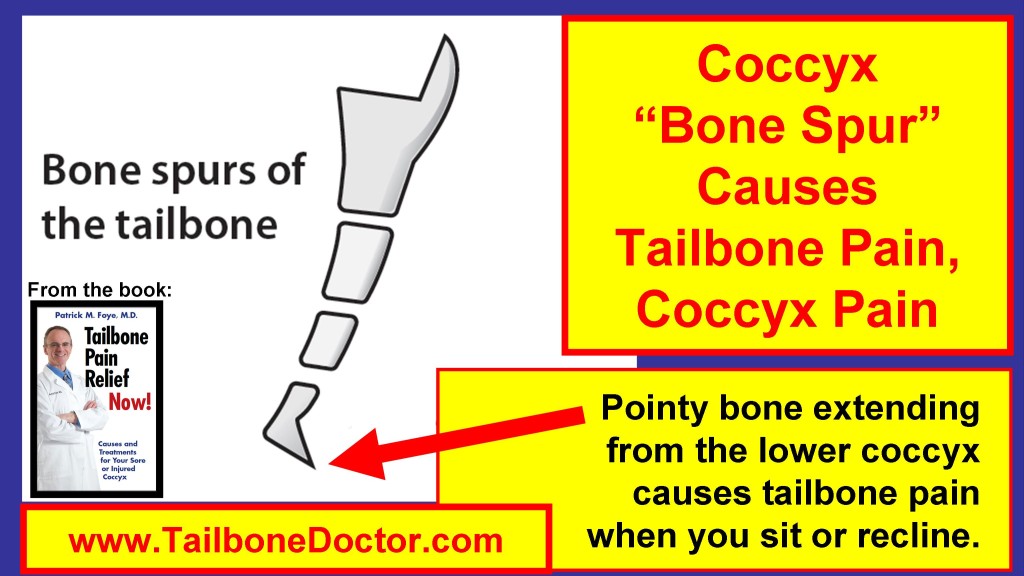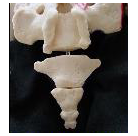There are many causes of coccyx pain (tailbone pain, coccydynia). This article will focus on coccyx pain being caused by the lower coccyx being in extension, which is called a pseudo-spur.
NORMAL COCCYX POSITION = FLEXION:
Normally, the coccyx position has a mild, gradual forward flexion. This means that the coccyx is flexed forward. This results in the lower coccyx being nicely “tucked in” (tucked into the pelvic, which protects the coccyx from hitting the chair or floor when you sit or fall).
ABNORMAL COCCYX POSITION = EXTENSION:
Sometimes the lower coccyx is positioned with the angle going the opposite way. The “opposite way” means that the coccyx may be in extension, instead of flexion. This results in the lower coccyx “sticking out” or “pointing backwards”. In this extended (“sticking out”) position, the tailbone is at risk for hitting against the chair or seat when you are sitting. Usually there is pain with sitting, and sitting leaning back makes the pain even worse. In this extended (“sticking out”) position, the tailbone is also at risk for hitting forcefully/traumatically against the floor or ground if you land on your butt after you slip and fall.
PHRASES and SIMILARITIES: Coccyx “BONE SPUR” (SPICULE) and “PSEUDO-SPUR”
- There are a few different phrases that doctors use to describe this abnormal, extended position of the tailbone.
- One phrase is to just say that the coccyx is in extension, instead of flexion.
- Another phrase is to say that there is a coccyx PSEUDO-SPUR. “Pseudo ” means “like” or “similar to”. So, pseudo-spur means “like a spur”.
- So, pseudo-spur means that the extended position of the lower coccyx results in the same type of symptoms as a bone spur. Usually there is pain with sitting, and sitting leaning back makes the pain even worse.
What is the DIFFERENCE between a coccyx BONE SPUR versus a PSEUDO-SPUR?
BONE SPUR:
- A bone spur is an area where there is thickening of the bone. It is made of bone. It is bone.
- A bone spur is additional, extra bone that the body has formed at a focal spot.
- Just like your skin can become “thickened skin” and form a skin callous. Similarly, the bone can become “thickened bone” and form a spur.
- A spur has EXTRA (ADDITIONAL) bone that has formed.
- When the bony thickening is focal and makes a pointy projection, we refer to it as a bone spur. European doctors sometimes call it a bone “spicule”.
- On imaging studies, a bone spur often looks like an icicle hanging down from your rain gutter.
- A lower coccyx bone spur can cause coccyx pain when the patient sits on the bone spur, thus impinging the skin and subcutaneous tissue in between the bone spur and the sitting surface.
PSEUDO-SPUR = EXTENSION = RETROVERSION:
- As discussed above, “pseudo-spur” means “like a spur”.
- But, the difference is that a SPUR has EXTRA (ADDITIONAL) bone. The pseudo-spur does NOT have an “extra” bone, it just that the normal amount of bone is going into extension instead of flexion.
- So, instead of the coccygeal joints being flexed, one or more of them are extended. Imaging trying to put your hand into your pocket if your index finger was extended, instead of flexed. The extended finger would get ‘hung up’ and would bump into the edge of the pocket rim, instead of being smoothly “tucked in” like the other fingers. Similarly, your extended coccyx may bump into the seat that you are sitting on, instead of being smoothly “tucked” into the pelvis.
- European doctors sometimes refer to this extension as “retroversion” of the lower coccyx.
MAKING A CLINICAL DIAGNOSIS = 3 FACTORS:
To make a clinical diagnosis, the doctor needs to consider three main factors:
- Symptoms: Does the patient report pain at one specific location? For example, is the patient having focal pain specifically at the lower tailbone? Also, is the pain worse with sitting, and especially worse with sitting while leaning slightly backwards?
- Physical exam findings: The doctor needs to specifically look at the skin over the location of pain. Then, the doctor needs to touch or press on different locations along the length of your tailbone (palpation) to see if this reproduces your pain or other symptoms. For a distal coccyx bone spur or a pseudo-spur, the specific location of tenderness will usually be at the lower half or lowest tip of the coccyx. (The doctor will usually also assess for other possible sources of pain in the pelvic or buttock region, beyond just the coccyx.)
- Imaging studies: Medical imaging studies of the coccyx include x-rays, MRI, and CT scans. If done properly, the imaging studies can show details of your coccyx anatomy. Typically the imaging studies will help to show if you have a coccyx bone spur (spicule) or a coccyx pseudo-spur (a retroverted coccyx, meaning that it is extended instead of flexed).
- All 3 Factors: All three of the above factors are important, in combination, in making a clinical assessment. If the patient’s symptoms, physical exam findings, and imaging studies all point to the same thing as being the cause of the patient’s symptoms, then the diagnosis is considered to be confirmed and well-established. Then we can move on to treatment options.
SUMMARY: I hope you have found this to be a helpful explanation of the coccyx pseudo-spur (extended, retroverted coccyx) as a source of coccyx pain (tailbone pain, coccydynia). I hope this has also helped to explain the similarities and differences between coccyx bone spurs and coccyx pseudo-spurs.

COME FOR RELIEF: For more information on coccyx pain, or to be evaluated in-person by Dr. Foye’s Coccyx Pain Center in the United States, go to: www.TailboneDoctor.com
– Patrick Foye, M.D., Director of the Tailbone Pain Center, New Jersey, United States.
- Coccygectomy: Expected Recovery and Return to Work after surgery for coccyx pain, tailbone pain. - November 28, 2023
- PRP Platelet Rich Plasma or Prolotherapy for Tailbone Pain, Coccyx Pain - October 25, 2023
- Reasons for Normal X-rays and MRI Despite Tailbone Pain, Coccyx Pain - October 3, 2023

